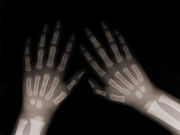Discordance in measures of digital ulnar angulation at the metacarpophalangeal joints
MONDAY, April 18, 2016 (HealthDay News) — For patients with rheumatoid arthritis (RA), there is discordance between radiological and goniometric measurements of ulnar deviation (UD) at the metacarpophalangeal joints, according to a study published online April 6 in the Journal of Medical Imaging and Radiation Oncology.
Regina M. Taylor-Gjevre, M.D., from the University of Saskatchewan in Saskatoon, Canada, and colleagues enrolled 15 RA patients with clinically apparent UD and 11 without UD who underwent rheumatological examination before recruitment. An occupational therapist (OT) performed goniometric measurements for UD at the metacarpophalangeal joints. Standardized hand radiographs and magnetic resonance imaging (MRI) studies of the dominant hand were assessed. Two experienced musculoskeletal radiologists independently performed angulation measurements for radiographs and MRI.
The researchers found that for both radiographic and MRI measurements, inter-observer correlation between radiologists was >0.97. The correlation between OT goniometric measurements and imaging-based measurements was 0.496 and 0.317 for radiographs and MRI, respectively. The correlation between imaging modalities was 0.513. Radiographic and MRI study measurements significantly underestimated the angulation in RA patients with UD, compared with OT measurements (P < 0.001).
“Although imaging plays a key role in understanding structural damage and disease activity in RA, it should be emphasized that radiological measurements underrate joint malalignment,” the authors write.
Copyright © 2016 HealthDay. All rights reserved.








